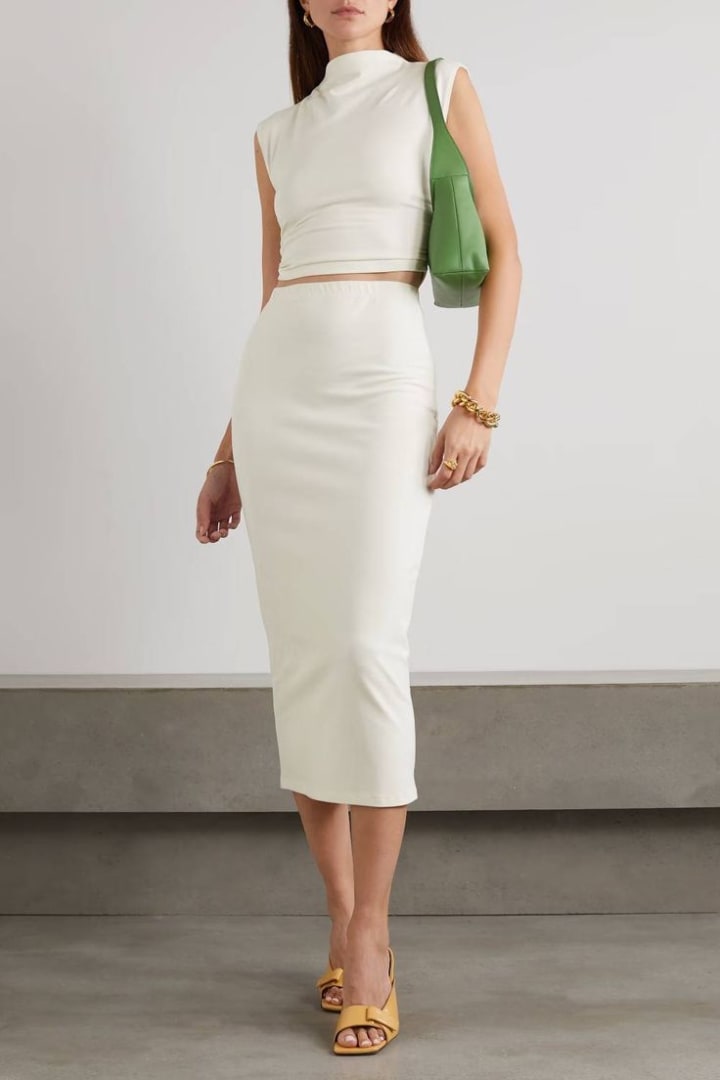Content warning
This story may contain sensitive material or discuss topics that some readers may find distressing. Reader discretion is advised. The views and opinions expressed in this story are those of the author and do not necessarily reflect the official policy or position of Vocal.
Sustainable Fashion: The Future of the Industry
How Eco-Friendly Practices Are Revolutionizing the Fashion World

How Eco-Friendly Practices Are Revolutionizing the Fashion World
In recent years, sustainable fashion has emerged as a transformative movement within the fashion industry, driven by increasing awareness of environmental issues and a growing consumer demand for ethical products. As the planet faces unprecedented challenges such as climate change, pollution, and resource depletion, the fashion industry is undergoing a significant shift toward sustainability. This article delves into the multifaceted world of sustainable fashion, exploring its importance, key practices, and the future of eco-friendly clothing.
The Importance of Sustainable Fashion
Environmental Impact
The traditional fashion industry is notorious for its significant environmental footprint. From the cultivation of raw materials to the manufacturing processes and the disposal of garments, each stage of the fashion supply chain has environmental repercussions. Conventional cotton farming, for instance, is pesticide-intensive and water-consuming, while synthetic fibers like polyester contribute to microplastic pollution.
Sustainable fashion aims to mitigate these impacts by adopting environmentally friendly practices. By utilizing organic and recycled materials, reducing water and energy consumption, and minimizing waste, sustainable fashion helps lessen the industry's burden on the planet. This shift is crucial in the fight against climate change and the preservation of natural resources.
Ethical Considerations
Beyond environmental concerns, sustainable fashion also addresses ethical issues related to labor practices. The fast fashion model often relies on cheap labor in developing countries, where workers may face poor working conditions, low wages, and limited rights. Sustainable fashion advocates for fair trade practices, ensuring that workers receive fair compensation and work in safe environments.
By supporting brands that prioritize ethical labor practices, consumers can contribute to a more equitable and just fashion industry. This not only improves the lives of workers but also promotes social responsibility and corporate transparency.
Key Practices in Sustainable Fashion
Use of Sustainable Materials
One of the cornerstones of sustainable fashion is the use of eco-friendly materials. Organic cotton, hemp, bamboo, and linen are popular choices due to their low environmental impact. Organic cotton, for example, is grown without synthetic pesticides and requires less water than conventional cotton. Hemp and bamboo are fast-growing plants that require minimal resources, making them sustainable alternatives.
Recycled materials are also gaining traction in sustainable fashion. Recycled polyester, made from post-consumer plastic bottles, helps reduce plastic waste and decreases the demand for virgin polyester. Similarly, upcycling old garments and textiles into new designs extends the life cycle of materials and reduces waste.
Zero-Waste Fashion
Zero-waste fashion is an innovative approach that aims to eliminate textile waste during the production process. Designers create patterns that use every piece of fabric, ensuring that no scraps are left behind. This technique not only conserves resources but also encourages creativity and precision in design.
Additionally, zero-waste fashion often involves repurposing discarded materials into new products. For example, designers might transform fabric scraps into accessories or incorporate them into patchwork designs. This practice not only reduces waste but also adds unique and artistic elements to the garments.
Ethical Manufacturing
Ensuring ethical manufacturing practices is a fundamental aspect of sustainable fashion. Brands committed to sustainability often partner with factories that adhere to fair labor standards, provide safe working conditions, and offer fair wages. Transparency in the supply chain is crucial, allowing consumers to trace the origins of their garments and verify ethical practices.
Certifications such as Fair Trade, Global Organic Textile Standard (GOTS), and OEKO-TEX Standard 100 provide assurance that products meet specific environmental and social criteria. By choosing certified products, consumers can support brands that prioritize ethical manufacturing.
Circular Fashion
Circular fashion is an emerging concept that promotes a closed-loop system where products are designed to be reused, repaired, and recycled. This approach extends the lifespan of garments and reduces the need for new resources. Brands embracing circular fashion often offer take-back programs, where customers can return old garments for recycling or resale.
Repair services and upcycling initiatives are also integral to circular fashion. By encouraging consumers to mend and repurpose their clothes, brands help reduce waste and foster a culture of sustainability.
The Role of Technology in Sustainable Fashion

Innovations in Textile Production
Technological advancements are playing a pivotal role in the evolution of sustainable fashion. Innovations in textile production, such as lab-grown fibers and biofabrication, are paving the way for more sustainable materials. For instance, companies are developing lab-grown leather using collagen, which eliminates the need for animal hides and reduces the environmental impact of leather production.
Biofabrication, which involves using living organisms to produce materials, is another promising area. Mycelium, the root structure of fungi, can be grown into a leather-like material that is biodegradable and eco-friendly. These cutting-edge technologies offer exciting possibilities for sustainable fashion.
Digital Fashion
The rise of digital fashion is also contributing to sustainability. Virtual fashion shows and digital clothing collections reduce the need for physical samples and travel, minimizing the industry's carbon footprint. Digital clothing, which can be worn in virtual environments or social media, offers a novel way for consumers to engage with fashion without the environmental impact of physical garments.
Moreover, 3D printing technology enables precise and on-demand production, reducing waste and excess inventory. By creating garments layer by layer, 3D printing minimizes material usage and allows for customization, further promoting sustainability.
Consumer Behavior and Sustainable Fashion
The Shift Toward Conscious Consumption
Consumer behavior is a driving force behind the sustainable fashion movement. As awareness of environmental and ethical issues grows, more consumers are seeking out sustainable and ethical brands. This shift toward conscious consumption is encouraging brands to adopt more sustainable practices and offer eco-friendly products.
Consumers are increasingly prioritizing quality over quantity, opting for timeless, durable pieces rather than fast fashion items. This change in mindset not only reduces waste but also supports the production of higher-quality garments that last longer.
The Role of Education and Advocacy
Education and advocacy play crucial roles in promoting sustainable fashion. Organizations, influencers, and activists are raising awareness about the environmental and social impacts of the fashion industry. By educating consumers on the benefits of sustainable fashion and how to make informed choices, these efforts are driving positive change.
Social media platforms and online communities are powerful tools for spreading awareness and fostering a sense of community among sustainable fashion advocates. By sharing information, tips, and personal experiences, individuals can inspire others to adopt more sustainable fashion practices.
Challenges and Opportunities
Overcoming Barriers
Despite its many benefits, sustainable fashion faces several challenges. One of the main barriers is the higher cost associated with eco-friendly materials and ethical manufacturing. Sustainable products often come with a higher price tag, which can be a deterrent for some consumers. However, as demand for sustainable fashion grows, economies of scale and technological advancements are expected to reduce costs over time.
Another challenge is the need for greater transparency in the fashion industry. While many brands are making strides toward sustainability, there is still a lack of standardized criteria and certifications. Ensuring transparency and accountability throughout the supply chain is essential for building consumer trust and driving industry-wide change.
The Role of Policy and Regulation
Policy and regulation can play a significant role in promoting sustainable fashion. Governments and regulatory bodies can incentivize sustainable practices through tax breaks, subsidies, and grants for eco-friendly initiatives. Implementing stricter regulations on environmental and labor standards can also compel brands to adopt more sustainable practices.
Collaboration between governments, industry stakeholders, and non-governmental organizations is crucial for creating a supportive framework for sustainable fashion. By working together, these entities can drive systemic change and foster a more sustainable and ethical fashion industry.
The Future of Sustainable Fashion
Innovations and Trends
The future of sustainable fashion is filled with exciting possibilities. Technological advancements, such as biodegradable textiles, smart fabrics, and sustainable dyeing techniques, are set to revolutionize the industry. As research and development in sustainable materials continue to progress, the fashion industry will have access to a broader range of eco-friendly options.
The trend toward minimalism and capsule wardrobes is also expected to grow. By curating a collection of versatile, high-quality pieces, consumers can reduce their environmental impact and simplify their lives. This shift toward mindful consumption aligns with the principles of sustainable fashion and promotes a more sustainable lifestyle.
The Power of Collaboration
Collaboration is key to advancing sustainable fashion. Partnerships between brands, designers, manufacturers, and consumers can drive innovation and create a more sustainable industry. By sharing knowledge, resources, and best practices, stakeholders can work together to address the complex challenges of sustainability.
Collaborative initiatives, such as fashion industry coalitions and sustainability-focused events, provide platforms for dialogue and action. By fostering a spirit of collaboration, the fashion industry can accelerate its transition toward sustainability.

Conclusion
Sustainable fashion represents a paradigm shift in the way we produce, consume, and think about clothing. By embracing eco-friendly materials, ethical manufacturing practices, and innovative technologies, the fashion industry can reduce its environmental impact and promote social responsibility. As consumers become more conscious of their choices and demand greater transparency, sustainable fashion is poised to become the future of the industry.
The journey toward sustainability is not without its challenges, but the opportunities for positive change are immense. Through education, advocacy, and collaboration, we can create a fashion industry that respects both people and the planet. Sustainable fashion is not just a trend; it is a movement that holds the promise of a more sustainable and equitable future for all.
Join Our Sustainable Fashion Community!
Are you passionate about fashion and committed to making a positive impact on the planet? Join our vibrant community of eco-conscious fashion enthusiasts, industry professionals, and advocates for sustainable living. Together, we can drive change and create a more ethical and sustainable fashion industry.
Why Join Us?
Stay Informed: Get the latest updates on sustainable fashion trends, innovative materials, and ethical brands.
Connect: Network with like-minded individuals who share your passion for sustainability and fashion.
Learn: Access exclusive resources, including educational articles, how-to guides, and expert insights.
Participate: Take part in community discussions, virtual events, and workshops to deepen your knowledge and make a difference.
Inspire Change: Be a part of a movement that promotes responsible consumption, environmental stewardship, and social equity.
What We Offer
Exclusive Content: Enjoy member-only content, including interviews with industry leaders, case studies, and behind-the-scenes looks at sustainable fashion practices.
Community Events: Attend webinars, Q&A sessions, and live discussions with experts and fellow members.
Support Network: Find inspiration and support from a community dedicated to making fashion more sustainable and ethical.
Opportunities to Contribute: Share your own experiences, insights, and ideas with the community. Your voice matters!
How to Join
Becoming a member is easy and free! Simply visit our website and sign up with your email address to start receiving our newsletter and access to all our community features. Follow us on social media to stay connected and engaged with the latest conversations in sustainable fashion.
Let's Make a Difference Together
By joining our community, you're not just staying informed—you're taking an active role in shaping the future of fashion. Together, we can make a significant impact and create a fashion industry that respects both people and the planet. Join us today and be part of the change!
Sign Up Now at Your Community, and follow us to start your journey towards a more sustainable fashion future

About the Creator
PT Stiga Brilu Official
Career Highlights:
Early Success: Gained acclaim with short stories and best-selling novels.
Themes: Explores identity, resilience
Impact: Actively participates in literary festivals, workshops, and mentoring.
Enjoyed the story? Support the Creator.
Subscribe for free to receive all their stories in your feed. You could also pledge your support or give them a one-off tip, letting them know you appreciate their work.






Comments
There are no comments for this story
Be the first to respond and start the conversation.